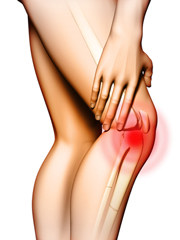About Osteoarthritis
What is Osteoarthritis?
Osteoarthritis (OA) is a painful condition involving the joints and related joint structures. Your joints are the areas where bones come together. With a healthy musculoskeletal system, your body can bend, move, and twist with ease. However, when OA develops, these common everyday movements become painful and problematic. Simply walking up steps or washing your hair can be difficult.
OA is a condition that primarily affects the spine, hips, knees, and hands, and this condition occurs through disease. With OA, there is defect of any of the tissues of the affected area, such as the diarthrodial joint, subchondral bone, synovium, capsule, periarticular muscles, sensory nerve endings, and/or meniscus (in the knee).
Unfortunately, there is no cure for this form of arthritis, but you can do some things to help control your pain and increase your mobility.
What Causes Osteoarthritis?
Mainly wear-and-tear on the cartilage of your joints causes OA. The cushioning inside the joints is called cartilage. This structure is a firm, slippery, thick tissue that covers and protects the ends of the bones in the section where they meet to form a joint. With OA, there is break down and erosion of this cartilage, allowing the bones to rub together resulting in pain and stiffness.
Researchers are unclear as to why the cartilage breaks down, but think that excess weight, genetics, aging, and joint injury all play a part in the process. Furthermore, OA may also be caused by other factors such as problems with the supporting ligaments, subchondral bone, synovium, capsule, periarticular muscles, sensory nerve endings, and/ or the meniscus (if present).
What are the Symptoms of Osteoarthritis?
Everyone’s symptoms are different. Some people only experience one or two of the common symptoms while others have all of them. These symptoms include:
- Pain – Your joints ache, throb, burn, or you have sharp stabbing discomfort.
- Stiffness – Moving around in the morning may be difficult. Your joints feel creaky and stiff for a short time until you get moving.
- Swelling – Your joints swell and feel tender and sore.
- Muscle Weakness – The muscles that surround your joint weaken, making walking more difficult.
- Joint Deformities – As the disease progresses, your joints start looking as if they are the wrong shape and size.
- Cracking and Creaking – When the condition is at its worst, you may hear popping, cracking, crunching, or creaking sounds in the joint.
- Reduced Range of Motion – As the osteoarthritis worsens, you may not be able to flex, extend, or bend your joints. Some people lose full mobility of one or more joints.
How is Osteoarthritis Diagnosed?
When you visit your doctor, he or she will make certain that your pain is not caused by another problem. The doctor will ask you questions regarding your symptoms and take X-rays to assess for joint degeneration and damage. Blood tests may be necessary to rule out other forms of arthritis. It may even be necessary for the doctor to order specialized diagnostic tests, such as ultrasound, or an MRI or DEXA scan.
How is Osteoarthritis Treated?
There are various treatments for osteoarthritis, although what works for others may not work for you. Your doctor will work with you to find the best therapy options to meet your needs. The goal of osteoarthritis treatment is to improve joint function and mobility, decrease or eliminate pain, and prevent further joint degeneration and damage. Your treatment may include:
- Pain Medication – Doctors frequently prescribe nonsteroidal anti-inflammatory drugs (NSAIDS), such as ibuprofen or naproxen. Another commonly used medication is acetaminophen (Tylenol). If these therapies do not reduce your pain, your doctor may find it necessary to prescribe a stronger analgesic.
- Joint Injections – Depending on your particular problem, the doctor may recommend a steroid joint injection or therapy with joint lubricating injections.
- Physical Therapy – The doctor may schedule physical therapy for you. Having stronger thigh muscles will help to reduce stress on your knees. The therapist will teach you exercises to relieve your discomfort, as well as heat and ice therapies.
- Weight Loss and Exercise – If you are overweight, your doctor may put you on a diet and exercise program. Other good activities for people with osteoarthritis include biking, swimming, and walking.
- Surgery – If your joint is severely damaged, the doctor may recommend a joint replacement. This surgery is only necessary for severe cases of osteoarthritis.
How is Osteoarthritis Prevented?
It is possible to prevent osteoarthritis. The most important thing you can do is keep your weight under control and get regular exercise. Focus on exercises that strengthen the muscles that surround your joints. The Arthritis Foundation recommends that you maintain good posture to protect your back and hips and to avoid injury to your joints, wear recommended safety gear and equipment. Always start new activities slowly to reduce the risk of injury to the joint.
References
- Balint, G. & Szebenyl, B. (1996). Diagnosis of osteoarthritis. Guidelines and current pitfalls. National Institute of Rheumatology and Physiotherapy, 52(3): 1 – 13.
- Brandt, K.D., Radin, E.L., Dieppe, P.A., van de Putte, L. (2006). Yet more evidence that osteoarthritis is not a cartilage disease. Annals of Rheumatic Diseases, 65(10): 1261 – 1264.
- Goldring, M.B. & Goldring, S.R. (2007). Osteoarthritis. Journal of Cellular Physiology, 213(3): 626 – 634.
- Hochberg, M.C., Altman, R.D., Brandt, K.D. et al. (1995). Guidelines for the medical management of osteoarthritis. Arthritis and Rheumatism, 38(11): 1535 – 1540. DOI: 10.1002/art.1780381103
- MayoClinic.com (2012). Osteoarthritis. Retrieved on December 12, 2012 from: http://www.mayoclinic.com/health/osteoarthritis/DS00019
Last reviewed 26/Feb/2014
Dr Merlin Thomas
Latest posts by Dr Merlin Thomas (see all)
- How to increase DHEA levels - 28/09/17
- Testosterone supplement benefits & risks - 11/07/17
- Health effects of tea & coffee - 10/07/17
